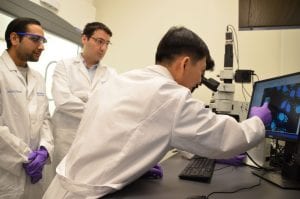 Micro-/Nano-particles for treatments of cardiovascular and lung diseases
Micro-/Nano-particles for treatments of cardiovascular and lung diseases
Polymeric micro-/nano-particles have been developed and commonly used to treat cancers; however, their application in treatments of cardiovascular and lung diseases has been limited. Dr. Nguyen’s group has developed various new biodegradable polymer micro-/nano-particles to effectively deliver various reagents, including drugs, proteins, small therapeutic molecules, and cDNA plasmids for gene therapy for treatments of vascular and lung disorders. In addition, micro-/nanoparticles could also be formulated and used as micro-/nanoscaffolds to recruit stem cells and facilitate cell growth at the injured site to provide in situ endothelialization for vascular healing and repair when the arterial wall is damaged by interventional cardiology procedures such as angioplasty and stenting.
Novel nanoparticles/nanomaterials for detecting and treating of cancers
Dr. Nguyen’s group has also developed various novel nanoparticles for cancer detection and therapy. Particularly, her research projects have focused on the development of stimuli-sensitive polymer nanoparticles that provide the controlled release of drugs in response to changes in the environment such as temperature and pH. These stimuli-sensitive polymer nanoparticles could significantly release the encapsulated drugs in responding to changes in pH of the tumor (acidic) environment and/or local tissue temperature provided by an external source (e.g. hyperthermia treatment), thereby leading to better therapeutic efficiencies for cancer therapies.
Nanocomposites for tissue engineering applications:
Dr. Nguyen has also developed various novel nanocomposite materials to provide sequential release profiles of therapeutic reagents for wound healing, tissue regeneration, and tissue adhesive applications. Her group took an initiative approach to develop multifunctional composite nanomaterials for locally controlled release of various therapeutic reagents to overcome limitations of traditional systemic delivery of these agents. These materials also consist of anti-microbial properties to prevent bacterial infection that is commonly observed in complex wounds.